After the 2017-18 season concluded, Nashville Predators general manager David Poile made few changes to the roster. That is unsurprising, as perennial Stanley Cup contenders rarely experience much turnover from season to season. Three players left the Predators in the offseason. Mike Fisher and Scott Hartnell retired, while Alexei Emelin signed with Avangard Omsk of the KHL. To fill those voids, Poile signed several free agents during the offseason.
Since it’s the All-Star break, and afterwards the team will be on their league-mandated bye week, it is as good a time as ever to review these additions and see how they have performed this season. In total, Poile signed six players to NHL contracts over the offseason and two made the opening night roster, Dan Hamhuis and Zac Rinaldo. Since then, Rocco Grimaldi and Colin Blackwell have received call-ups with Grimaldi becoming a regular.

Although all four mentioned in the previous paragraph have played in at least one NHL game this season, this article is about Grimaldi, Hamhuis and Rinaldo, all with at least 20 NHL games this season. My goal is to look at their impacts and, based on what they were signed to do, give them a grade.
Dan Hamhuis
When the Predators signed Hamhuis to a two-year deal with a $1.25 million cap hit, it signified a reunion with the veteran defenseman whom they drafted 12th overall at the 2001 Entry Draft. He played six seasons with the Predators during his initial stint and appeared in 483 regular season games with 32 goals and 161 points. He also helped the team get to five postseason appearances.
They dealt him to the Philadelphia Flyers in June 2010 and he signed as a free agent with the Vancouver Canucks in July 2010. He played six seasons in Vancouver and accumulated 389 games, 23 goals and 142 points and helped them win consecutive Presidents’ Trophies in 2011 and 2012, and reached the 2011 Stanley Cup Final.
In July 2016, he signed with the Dallas Stars and played two seasons with them. He totaled 159 games, four goals and 40 points. Then, on July 25, 2018, he signed with the Predators. In total, he played in 1,031 regular season games, netted 59 goals and totaled 343 points while averaging 22:02 per game entering this season.
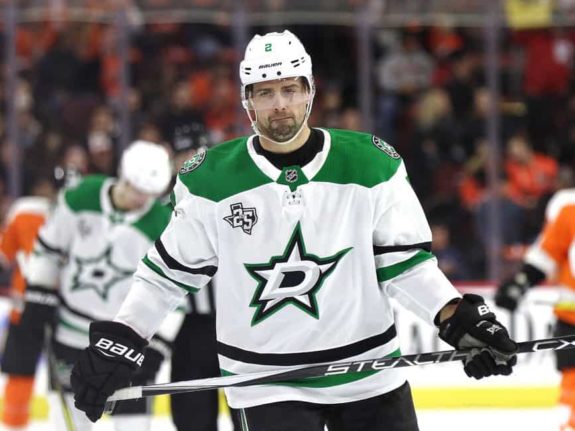
Why Did They Sign Him?
The Predators signed Hamhuis to serve as a depth defenseman on their third pair with the potential to move up the depth chart as injuries dictated. Given the status of the team’s top-four when healthy, he was expected to have reduced minutes, be a shutdown defender, play a fair bit on the penalty kill and be somewhat insulated.
He was not, however, expected to generate a lot of offense from the blue line, something he has done less and less as his career has progressed. But that was okay because they were getting enough production from the top-four and anything Hamhuis provided was a bonus.
How Has He Performed in 2018-19?
In 41 games this season, Hamhuis has four points, all assists, is a plus-one and has a minus-19 turnover margin while averaging 17:02 per game. He missed 11 games earlier in the season when he went on injured reserve between Oct. 25 and Nov. 15 with an undisclosed injury.
His five-on-five metrics haven’t been great: 48.5 shots for percentage (SF%), 48.6 scoring chances for percentage (SCF%), 50 percent goals for percentage (GF%) and 45.9 high-danger scoring chances for percentage (HDCF%). He is starting in the offensive zone 47.5 percent of the time, fourth-highest of his career.
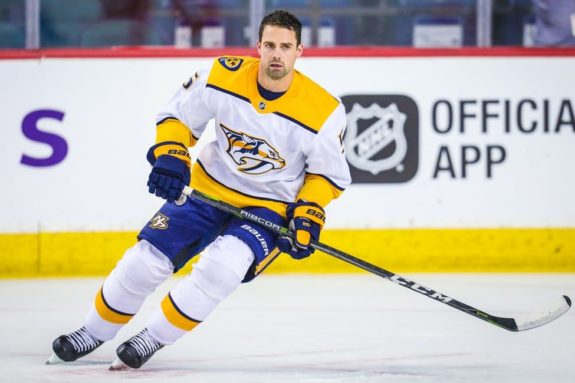
His five-on-five rates indicate that he isn’t generating offense, further supporting the theory he was signed to take on a shutdown role. His 14:55 per game at five-on-five is a career-low as are his points-per-60, shots-per-60 and individual scoring chances for per-60. His individual high-danger chances generated per-60 are his third-lowest. Even his individual points percentage (IPP), a stat that measures the percentage of goals a player records a point on when he is on the ice, is a career-low 21.1.
On the penalty kill, a situation he was signed to play in, he has averaged 1:41 per game, the lowest of his career. When he is deployed, the Predators allow 43.4 shots-per-60 (S/60), .87 goals-per-60 (G/60), 36.5 scoring chances per-60 (SCA/60) and 17.4 high-danger chances per-60 (HDCA/60). The team’s goaltenders also have an .880 save percentage (SV%) when he’s deployed on the penalty kill and he’s been on the ice for 19.4 percent of opponents’ power play goals.
How Is He Affecting His Partners?
Hamhuis has played on three different defense pairs for at least 50 minutes at five-on-five. He has played the most with Mattias Ekholm (344 minutes) due to P.K. Subban’s injury that held him out of the lineup for 19 games in November and December.
Related: Predators’ Ekholm Deserves Norris Consideration
When Hamhuis and Ekholm have been together, they have a 51.5 Corsi for percentage (CF%), a minus-1.49 relative Corsi for percentage (RelCF%), a 47.1 GF% and a minus-10.2 relative goals for percentage (RelGF%) while starting in the defensive zone 33.6 percent of the time. Predators goaltenders also have a .941 SV% with the pair deployed. A note about relative stats – they are relative to other Predators pairs (or players), so a negative means that pair (or player) is worse than the average Nashville pair or player.
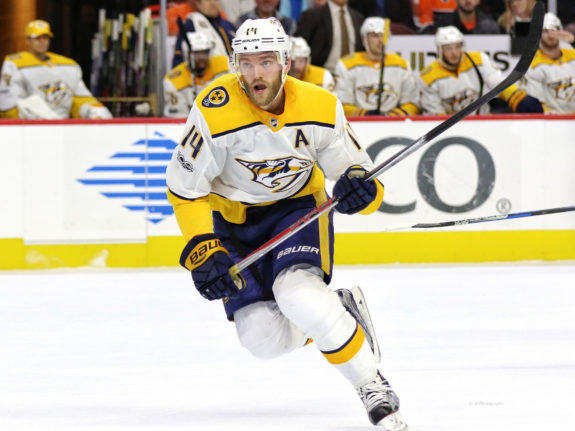
Hamhuis’ second-most common partner is Yannick Weber, having shared 114 five-on-five minutes. This pair has a 44.1 CF%, a minus-10.7 RelGF%, a 50 GF%, a minus-4.55 RelGF% and the team has a .906 SV% while they start in the defensive zone 30.2 percent of the time. He’s played 55 minutes with his third-most common partner Matt Irwin. Together, they have a 54.3 CF%, a 1.88 RelCF%, a 66.7 GF%, a 12.1 RelGF% and a .960 SV% as a team while they start in the defensive zone 40.7 percent of the time.
Using the With or Without You stat, which measures how successful players are together versus apart, Hamhuis drags down Ekholm and Irwin. Meanwhile, he and Weber don’t have strong metrics together nor apart. So, in conclusion, the pair with Irwin is Hamhuis’ most successful, however it’s also the least-used pair. His pair with Ekholm has been successful as well, while he and Weber don’t play well together. What’s interesting about this conclusion is that Hamhuis is a left shot, as are Ekholm and Irwin, while Weber is a right shot, so Hamhuis doesn’t need a right-shot partner to play well.
Rank Among Predators Defensemen
The Predators have only used eight defensemen this season, and all have at least 150 five-on-five minutes under their belts. At five-on-five, Hamhuis ranks seventh in shots for percentage, sixth in scoring chances for percentage, seventh in high-danger chances for percentage, sixth in time on ice per game, third in shots against per-60, fifth in goals against per-60, third in scoring chances against per-60 and fourth in high-danger chances against per-60. He is also tied for eighth in goals for percentage.
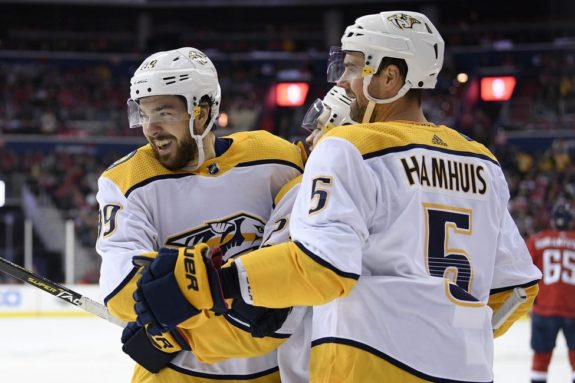
On the penalty kill, he’s fourth in time on ice per game, second in shots against per-60, first in goals against per-60, third in scoring chances against per-60, sixth in high-danger chances against per-60 and first in on-ice save percentage. What this says is that, for one, Hamhuis is one of the team’s more effective penalty killers although that’s largely the result of goaltending, and two, while he doesn’t generate much five-on-five offense, he is effective at shutting down the opposition.
Grade: B
I gave the Hamhuis signing this grade because he is a defensive defenseman who has done his job. His pairs with Ekholm and Irwin aren’t getting caved in as badly as I originally thought and that’s while receiving difficult assignments and zone starts. He’s also a steadying, veteran presence on a blue line that lacked one last season and could be a great partner if top defense prospect Dante Fabbro joins the team in the spring.
Rocco Grimaldi
On July 1, 2018, the Predators signed 25-year-old Grimaldi to a one-year, $650,000 deal. However, because it was a two-way contract, he only receives that salary if he is in the NHL. If he is in the AHL, as he was to start the season, his salary drops to $175,000. The Florida Panthers originally drafted him in the second round of the 2011 Entry Draft.
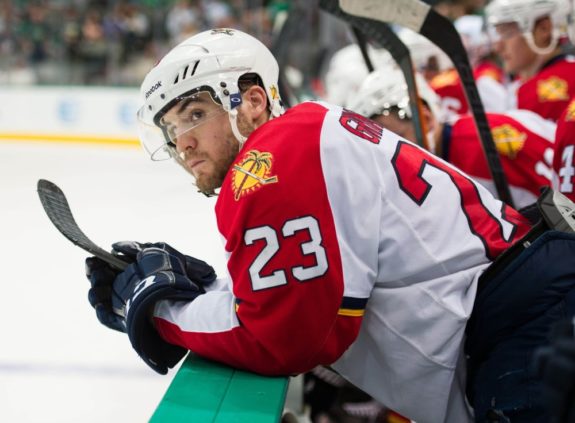
He played 27 games across two seasons with the Panthers and accumulated four goals and six points. In June 2016, the Panthers traded him to the Colorado Avalanche with whom he appeared in 10 games across two seasons and totaled one goal and three assists. The Predators signed him to provide depth offense and perhaps get surprise production from a former second-round pick who may have untapped potential remaining. He was supposed to mainly stay in the AHL and go between that league and the NHL as injuries created need.
How Has He Performed in 2018-19?
At the All-Star break, Grimaldi has appeared in a career-high 33 games. He’s scored four goals and eight points, both career highs, while averaging 9:56 per game. He also has a plus-10 turnover margin. He was called up in response to the injuries to Filip Forsberg, Viktor Arvidsson and Kyle Turris. At five-on-five, the Predators have a 59.5 SF%, 54.8 SCF%, 47.4 GF% and 49 HDCF% with him deployed while he starts in the offensive zone 73.5 percent of the time. Overall, they are the strongest metrics of his career. He also has 11 points in 10 AHL games this season.
Also at five-on-five, he is averaging 9:48 per game with scoring rates of .74 G/60, 1.48 P/60, 9.83 S/60, 9.64 individual scoring chances per-60 (iSCF/60) and 3.34 individual high-danger chances per-60 (iHDCF/60). He also has an IPP of 88.9, a percentage that is almost unbelievably high. I didn’t rank his season relative to his career because he’s played so few games in his career that it greatly skews his scoring rates.
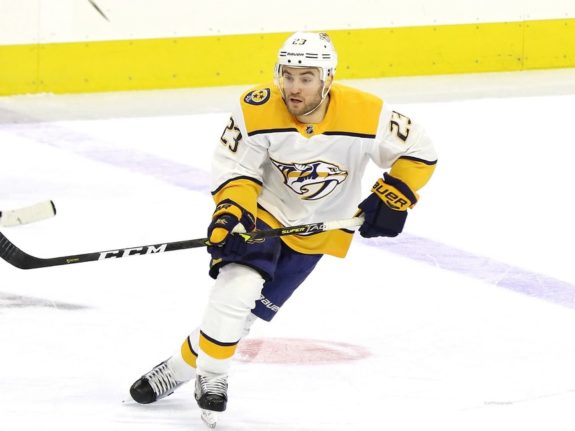
Grimaldi has generally been on Nashville’s fourth line this season and has occasionally moved up the lineup. He has spent the majority of his time on a line with Frédérick Gaudreau and Mikka Salomäki, with 71 shared five-on-five minutes. Together, the line has quite strong metrics of a 68.1 CF%, a 17.4 RelCF%, a 50 GF%, a minus-6.25 RelGF% and a 68.8 SF% while starting in the offensive zone 41.1 percent of the time.
He also ranks well among Predators forwards. There have been 14 Nashville forwards who have played at least 300 five-on-five minutes this season. Grimaldi ranks second in shots for percentage, 12th in goals for percentage, third in scoring chances for percentage and seventh in high-danger chances for percentage.
Grade: A
With Grimaldi, the Predators are getting strong production from a player on a league-minimum contract. He has exhibited strong two-way play, is tenacious on the forecheck and safe with the puck. He also scored one of the nicest goals by a Predator this season.
Zac Rinaldo
On July 2, 2018, the Predators signed Rinaldo to a one-year, two-way, $650,000 contract that is valued at $300,000 in the AHL. The Flyers drafted him in the sixth round of the 2008 Draft and he has largely been used as a grinder/agitator in the NHL. He played in 223 games with the Flyers and totaled eight goals, 24 points and 572 penalty minutes.
They traded him to the Boston Bruins in June 2015 and he played 52 games in one season with them. He had one goal, two assists and 83 penalty minutes as a Bruin. In July 2017, he signed with the Arizona Coyotes as a free agent. He played in 53 games with Arizona and accumulated five goals, two assists and 44 penalty minutes. I’m not entirely certain why the Predators signed him, but I have a few ideas that I’ll get to later.
How Has He Performed in 2018-19?
In 2018-19, Rinaldo has one goal, two assists, 20 penalty minutes and a plus-two turnover margin in 23 games while averaging 7:07 per game. He is currently on injured reserve with an undisclosed injury. As one might expect from a player with Rinaldo’s skillset, he has poor metrics: 46.6 SF%, 47.6 SCF%, 57.1 GF% and 48.7 HDCF% while starting in the offensive zone 46.9 percent of the time. He also has two major penalties on the season.
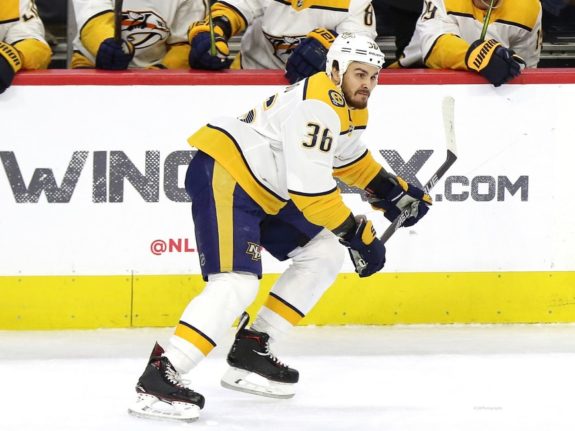
At five-on-five, he is averaging 7:04 per game, .37 G/60, 1.11 P/60, 4.06 S/60, 3.69 iSCF/60 and 1.11 iHDCF/60. He also has a 75.0 IPP. He has mostly played on a line with Colton Sissons and Salomäki with 49 shared minutes. Together, the line has a 49.3 CF%, a 1.50 RelCF%, a 50 GF%, a minus-17.7 RelGF% and a 57.7 SF% while starting in the offensive zone 15.2 percent of the time.
Among the 15 Predators forwards with at least 150 five-on-five minutes, Rinaldo ranks 15th in shots for percentage, sixth in goals for percentage, 13th in scoring chances for percentage and eighth in high-danger chances for percentage.
Grade: D
For starters, as I mentioned above, I can’t figure out why Poile signed Rinaldo. I suppose it could have been to provide an agitating presence during Austin Watson’s suspension. However, Rinaldo is a less-talented version and Watson has been back for several months. With Watson back in the lineup, Rinaldo no longer serves a purpose on the roster. He doesn’t score, rarely has the puck on his stick, isn’t the fastest skater and isn’t even fighting that often.
How Did Poile Do in General?
In totality, the Predators GM did well with his offseason additions. He spent less than $3 million in annual salary to bring in three players. Hamhuis brought depth defense and a shutdown, veteran presence to the blue line and Grimaldi has represented surprise production from a depth forward. Both were signed to value contracts. I don’t understand why Rinaldo was signed as he hasn’t been worth much, but at least his contract was cheap.
Hamhuis and Grimaldi have contributed to get the Predators to their current place in the standings. Now at the All-Star break and bye weeks, the league begins to turn its attention to the Feb. 25 trade deadline. The Predators are no different. Poile generally did well in free agency last offseason and will look to have the same success in acquiring additional talent for the stretch run and postseason.
*All stats came from Hockey-Reference, Natural Stat Trick and Corsica Hockey